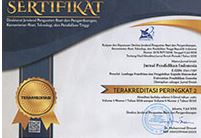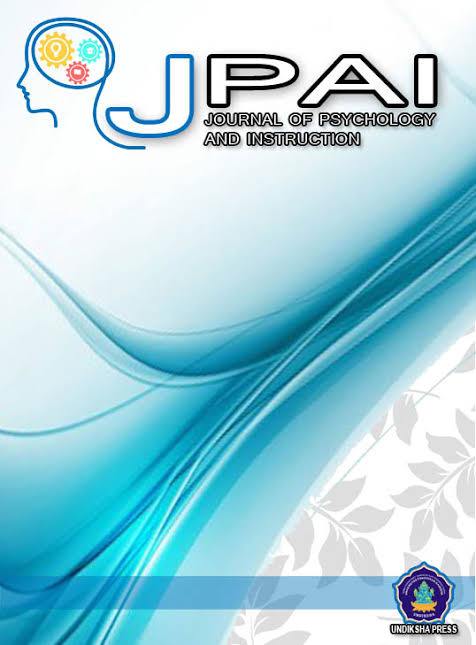INVESTIGATING SPEAKING ANXIETY OF THE TENTH GRADE STUDENTS AT SMA NEGERI 4 SINGARAJA
DOI:
https://doi.org/10.23887/jpai.v2i2.15978Abstract
This present study was aimed at investigating the levels of students’ speaking anxiety and the most dominant factor influencing students’ speaking anxiety. This study was a cross sectional survey with quantitative method. The population of this study was the tenth grade students of SMA Negeri 4 Singaraja in academic year 2017/2018. Simple random sampling was used as the sampling technique. The total number of the sample was 110 students who were chosen randomly from 11 classes. The data was gathered by using questionnaire. Then, it was analyzed by finding out the percentage of the students’ speaking anxiety level and mean score for the most dominant factor influencing students’ speaking anxiety. The result of this study showed that most of the students were in mildly anxious level with the percentage 51%. It followed by 24% students felt anxious and 24% of them felt relaxed. Additionaly, 1% student was categorised as very anxious level and only 1% of was in very relaxed level. Finally, in this present study, it was found that cognitive factor was the most dominant factor influencing students speaking anxiety.References
Abdullah, K. I., & Rahman, N. L. A. (2010). A study on second language speaking anxiety among UTM students. Fakulti Pendidikan, Universiti Teknologi Malaysia, 1-6.
Basic, L. (2011). Speaking anxiety: An obstacle to second language learning?. Taken from: http://www.diva-portal.org/smash/record.jsf?pid=diva2:453921. Retrieved on December, 28th 2016.
Brown, H. (2001). Teaching by Principles: An Interactive Approach to Language Pedagogy.(2nd edition). New York: Longman, Inc
Debreli, E., & Demirkan, S. (2015). Sources and levels of foreign language speaking anxiety of English as a foreign language university students with regard to language proficiency and gender. International Journal of English Language Education, 4(1), 49-62.
Djigunovic, J.M. 2006. Role of Affective Factors in the Development of Pro-ductive Skills. Zagreb: University of Zagreb.
Field, J. (2011). Examining speaking: Research and practice in assessing second language speaking, Cambridge: University of Cambridge ESOL Examinations 65-111.
Fraenkel, J. R., Wallen, N. E., & Hyun, H. H. (2012). How to Design and Evaluate Research education. New York: McGraw-Hill.
Hadziosmanovic, Lejla. (2012). Students Perspective on Speaking Anxiety and Dynamic in the ESL Classroom. Taken from: http://dspace.mah.se/bitstream/handle/2043/13641/Speaking%20Anxiety%20and%20Classroom%20Dynamics.pdf?sequence=2. Retrieved on December, 27th 2016.
Hair, J.F., Black, W.C., Babin, B.J. & Anderson, R.E., (2010). Multivariate Data Analysis. In Multivariate Data Analysis. New Jersey: Pearson Education Inc. pp.91-149.
Harmer, J. (2001). The Practice of English Lnaguage Teaching. Third Edition. London: Longman.
Horwitz, E.K. (2010). Foreign and second language anxiety. Language Teaching, 43, 154-167.http://dx.doi.org/10.1017/S026144480999036X.
Horwitz, E. K., et. al.(1986). Foreign Language Anxiety, The Modern Language Journal. Vol. 70.
Krashen, S. (2009). Principles and practice in second language acquisition (internet edition). Taken from: http://www.sdkrashen.com/content/books/principles_and_practice.pdf. Retrieved on May, 27th 2017
Lindsay, P. H., & Norman, D. A. (2013). Human information processing: An introduction to psychology. Academic Press.
Liu, M. & Jackson,J., (2008). An exploration of Chinese EFL learners‟ unwillingness to communicate and foreign language anxiety. Mod. Lang. J. 92, 71-86.
Luo, H. (2014). Foreign language speaking anxiety: A study of chinese language learners. Journal of the National Council of Less Commonly Taught Languages, 15, 99-117.
MacIntyre, P. D., & Gardner, R. C. (1989). Anxiety and second‐language learning: Toward a theoretical clarification. Language learning, 39(2), 251-275.
Mahpudilah, S. N. A. (2016). The Attribution On Students’speaking Anxiety In Efl Classroom. Journal of English and Education, 4(2), 101-114.
McCroskey, J. C. (1977). Oral communication apprehension: A summary of recent theory and research. Human communication research, 4(1), 78-96.
Mulasari, F. C. (2015). The Effectiveness Of Using Guessing Game For Teaching Procedure Text In Speaking (An Experimental Research At Second Grade Students Of Smk Muhammadiyah 1 Purwokerto In Academic Year 2014/2015. (Doctoral Dissertation, Universitas Muhammadiyah Purwokerto).
Nunan, D.(2003). Practical English Language Teaching. New York: McGraw-Hill.
Siniscalco, M. T., & Auriat, N. (2005). Questionnaire design. Quantitative research methods in educational planning. UNESCO International Institute for Educational Planning, Paris.
Strongman, K. T. (1995). Theories of anxiety. New Zealand Journal of Psychology, 24(2), 4-10.
Taylor, L. (2011). Examining Speaking: Research and practice in assessing second language speaking (Vol. 30). Cambridge University Press.
Tercan, G., & Dikilitaş, K. (2015). EFL students’ speaking anxiety: a case from tertiary level students. ELT Research Journal, 4(1), 16-27.
Tse, Y. H. A. (2011). To Be Anxious or Not to be Anxious--That's the Question in Public Speaking. Taken from: https://www.diva-portal.org/smash/get/diva2:453921/fulltext01.pdf. Retrieved on December, 27th 2016.
Tuan, N. H., & Mai, T. N. (2015). Factors affecting students’ speaking performance at Le Thanh Hien high school. Asian Journal of Educational Research, 3(2), 8-23.
Utomo, H. B. (2015). Profile of Student Fear Public Speaking Based On Emotional Maturity and Self Efficacy. Journal of Education Science Universitas Ubudiyah Indonesia, 1(1), 45.
Witt, P. L., Roberts, M. L., & Behnke, R. R. (2008). Comparative patterns of anxiety and depression in a public speaking context. Human Communication, 11(2), 219-230.
Zhiping, D., & Paramasivam, S. (2013). Anxiety of speaking English in class among international students in a Malaysian university. International Journal of Education and Research, 1(11), 1-16.










